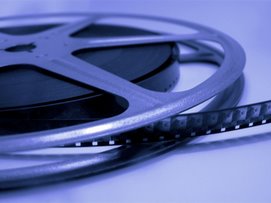After his pregnant girlfriend had a heavy handed abortion, Bernard Nathanson decides to become a doctor to perform safe abortions for women. He joins Larry in a pro-abortion movement in the 60s, trying to get it legalized. Norma McCorvey wants to have an abortion in Texas, so the lawyers list her as “Jane Roe” and go all the way to the Supreme Court to legalize abortion. This leads to the Roe v. Wade judgement in 1 9 7 3, in which the justices legalize abortion with a 7-2 vote. After seeing an aborted fetus, Nathanson becomes a pro-life activist.
Every topic can in theory be suitable for a movie. But there are right ways and wrong ways when handling a controversial topic. And the movie “Roe v. Wade”, about the famous Supreme Court case which legalized abortion in America, did it the wrong way: it’s biggest problem is that it stooped down to an ideological and an emotional appeal, when it should have just taken the perspective of a legal appeal. Since it is a rarely talked about event in cinema, the Roe v. Wade case is intermittently interesting: it depicts how abortion doctor Bernard Nathanson joined others to try to make abortion legal, as to get his profession out of the area of semi-illegality, and thus their grassroots movements found a great case to test the practice, Norma McCorvey, who wanted to have an abortion in Texas, where it was banned. The lawyers Sarah Weddington and Linda Coffee deliberately aimed her court case at the Supreme Court. However, this is where the story involving Dr. Nathanson should have stopped, and focused on the sole Roe v. Wade case. Bizarrely, the storyline did the opposite. The movie spends only 30 minutes on the said Supreme Court case, while the remaining 80 minutes involving both pro-choice and pro-life movements are given undue weight, since they are off-topic. They are simply outside the scope of the topic, since the main theme is the Roe v. Wade case. Ironically, the movie is at its best during these scarce courtroom sequences, which are calm and restrained. Jon Voight, as Justice Burger, is thus underused, yet a small surprise here is Stacey Dash, unexpectedly delivering a very good performance. For some reason, the film treats the verdict as some sort of conspiracy: yes, there was pressure from both sides to swing the case in their favor (Nathanson and his pro-abortion associate Larry brag at the beach how they inserted false statistics and published them by Time magazine; two Justices, Stewart and Blackmun, allegedly had a wife and a daughter, respectively, who both worked at the Planned Parenthood association, insinuating they were in the conflict of interest), but these are straw man arguments, since in reality this just reveals the author’s lack of understanding of the legal system— a judge is not guided by any emotion or outside media interference, only by objective, referenced, reasonable interpretation, expansion and exploration of the international law and constitution, based on equilibrium of rights and autonomy. And nothing from the story disputes the latter.
Several sequences are highly dubious and misrepresenting: for instance, activist Margaret Sanger from Planned Parenthood is depicted as a racist holding a speech in front of people with a cross burning behind her, as the movie heavy-handedly inserts an association fallacy that the origins of the US abortion movement are linked to a person who wanted to “reduce the Black population”. At least some credit should be given to the two directors for presenting both sides of the argument, thereby at least nominally trying to stay neutral. Yet certain aspects still lean towards one side: in one particularly exaggerated sequence, the police storm a hotel room that is performing abortions. One doctor, though, just continues doing the procedure on a woman lying on the bed while holding an instrument, saying: “This is an operating room! You have no authority here!” A police officer then lowers his gun and punches the doctor with his fist (!) — not even asking if the procedure is maybe already half-way done or what the woman is now supposed to do, just suck it back in? In another over-melodramatic moment, pro-life activist Mildred is watching “Golden Girls” on TV, in which a woman says that going to an abortion is like “going to the dentist”, which shocks Mildred’s mother so much she drops a plate from her hand, which smashes on the floor. All these episodes are unnecessary and irrelevant for the main trial, since none of them had any influence on the verdict, anyway. What was the point of inserting five sequences of abortion clinics? The movie would have been so much better if it decided to stick to just the said trial, and showing the lawyers giving arguments for and against abortion, as in the sequence where a debate is held as to when a fetus can be considered a person. This way, though, it is not a movie about Roe v. Wade, but about the conversion of Dr. Nathanson. Unfortunately, this seems like a movie version of a Wikipedia:Coatrack article—instead of neutraly exploring a theme, it has been edited to promote a point or argue about something else.
Grade:+





No comments:
Post a Comment